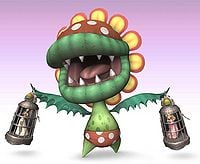Boss
Bosses are characters in the Super Smash Bros. series that appear when certain conditions are met. These conditions range from simply clearing stages with a certain difficulty and time, to playing certain Event Modes.
There are multiple battles in the Smash Bros. series that could be considered boss battles; however, actual bosses are usually unplayable by normal means, and most are much larger than the playable characters.
The Hand Bros.
Master Hand
- Main article: Master Hand
The first “true” boss of the Smash Bros. series, Master Hand is the master of ceremonies for the Smash Bros. series. He is meant to represent the hand of a child playing with his toys and staging storyless fights between his favorite Nintendo characters (the playable characters in the game are, in fact, no more than dolls made to look like Nintendo characters). He first appeared in the introduction to the first Super Smash Bros., bringing the characters shown in the intro to life. He then appeared at the end of the 1-Player Mode as the final boss. Going against usual Smash tradition, Master Hand has a certain amount of health that must be whittled down to 0%, as opposed to a percent that must be racked up, leading to a KO; this is due to Master Hand’s massive size and being unaffected by the knockback of attacks. Upon being defeated, Master Hand lets out a deep roar that almost sounds like laughing, and flies off, writhing and exploding, into the distance.
Master Hand reappeared in Super Smash Bros. Melee, reprising his role as the final boss in the 1-Player Mode, now called Classic Mode. Master Hand is fought on Final Destination, which is very similar to his original stage, Master Hand’s Residence. He fights essentially the same way as he did in the original game, but with a few new attacks. Upon being defeated, he leaves the stage in the same way that he did in the original game.
It is unknown if Master Hand will reappear in Brawl; however, Classic Mode is confirmed to be returning, and it is likely that Master Hand will have the same role in the game as before.
Crazy Hand
- Main article: Crazy Hand
The strange, twisted brother of Master Hand, Crazy Hand is meant to represent the feeling of destroying one’s own creations, as opposed to Master Hand, who is meant to represent the opposite. He was introduced in Super Smash Bros. Melee as a secret boss who would only fight alongside Master Hand under certain conditions. The first of these conditions is clearing Classic Mode on Normal difficulty in less than 18 minutes; Crazy Hand will join Master Hand when Master Hand has half of his health left. Crazy Hand can also be fought in Event Mode 50: Final Destination Match, where he and Master Hand are fought at Final Destination with 300% health each.
When compared to Master Hand, Crazy Hand can be considered to be much more erratic and, living up to his name, crazy. His idle pose is a strange, erratic movement, and he has multiple strange attacks that Master Hand does not. When Master Hand and Crazy Hand are fought together, they have multiple moves that they use in conjunction with each other, such as a high-powered clapping attack.
Master Hand also appears in the Gameboy Advance game, Kirby and the Amazing Mirror, in which he appears as a miniboss in multiple areas. Upon being defeated, Kirby can inhale him, like other minibosses, and gains the Smash ability, which is based on Kirby’s moveset in Melee. Master Hand, alongside Crazy Hand, also appears as the boss of the Candy Constellation. This is Crazy Hand’s only appearance in the game. The two, like in Melee, have conjunction attacks that they use together. Neither can be inhaled here, as they both exploded upon defeat.
Giga Bowser
- Main article: Giga Bowser
Giga Bowser (known as Giga Koopa in Japan) is the secret final boss of Adventure Mode in Melee. As his name suggests, he is a large, powered-up version of Bowser. With a manic expression, a darker, more malevolent color scheme, and a hulking size, Giga Bowser is surely a boss to be remembered.
Upon clearing Adventure Mode in less than 18 minutes on Normal difficulty, Bowser’s trophy, previously thrown into a mysterious abyss below Final Destination, rises back up onto the stage, and is struck by a strange lightning, transforming it into Giga Bowser. During the battle with Giga Bowser, a distorted version of the Final Destination theme that cannot be found in the Sound Test plays. Many of Giga Bowser’s attacks are powered up from Bowser’s, making him a challenge to defeat. His Down Smash attack has an icy effect, while his Forward Smash has explosive properties. His Forward Tilt has shadow-like effects. His Fire Breath attack never diminishes like Bowser’s.
Giga Bowser also makes a semi-playable appearance in Brawl as Bowser’s Final Smash, Giga Bowser Transformation. When used, Bowser temporarily transforms into Giga Bowser, who is essentially unchanged from Melee, keeping the elemental abilities of his attacks, as well as his massive size.
Petey Piranha
- Main article: Petey Piranha
Petey Piranha (known as Boss Pakkun in Japan) is the first revealed boss character in Brawl, and the first “true” boss to come from another series of games, as opposed to being original to. He appears as a boss in The Subspace Emissary, holding cages that contain Princess Zelda and Princess Peach. He uses both these cages, as well as his own abilities, to attack the player. The cage the player attacks more determines which cage will break when Petey is defeated and explodes. The other princess is turned into a trophy, and subsequently taken, by Wario.
